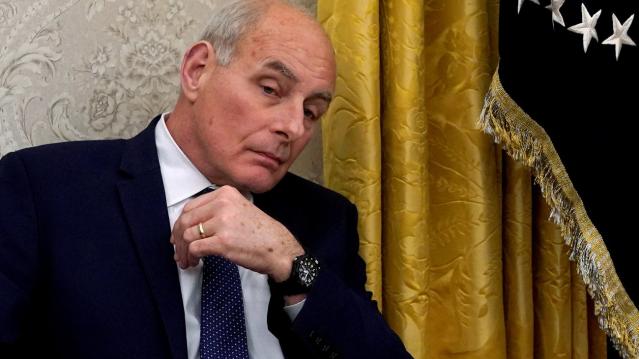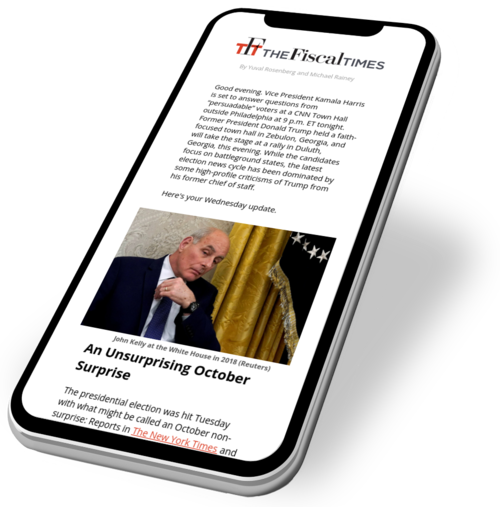Harris Economic Plan 'Vastly Superior,' 23 Nobel Prize Winners Say

Good evening. Vice President Kamala Harris is set to answer questions from “persuadable” voters at a CNN Town Hall outside Philadelphia at 9 p.m. ET tonight. Former President Donald Trump held a faith-focused town hall in Zebulon, Georgia, and will take the stage at a rally in Duluth, Georgia, this evening. While the candidates focus on battleground states, the latest election news cycle has been dominated by some high-profile criticisms of Trump from his former chief of staff.
Here's your Wednesday update.
An Unsurprising October Surprise
The presidential election was hit Tuesday with what might be called an October non-surprise: Reports in The New York Times and The Atlantic in which John Kelly, the former Marine general who was the longest-serving White House chief of staff under President Donald Trump, said that Trump fits the definition of a fascist and would govern as a dictator if allowed. “Certainly the former president is in the far-right area, he’s certainly an authoritarian, admires people who are dictators — he has said that. So he certainly falls into the general definition of fascist, for sure,” Kelly told the Times.
Kelly also said that Trump had praised Adolf Hitler, remarked that he wanted generals like Hitler’s and repeatedly disparaged American military leaders and servicemembers, including using the terms “suckers” and “losers.”
“He’s certainly the only president that has all but rejected what America is all about, and what makes America America, in terms of our Constitution, in terms of our values, the way we look at everything, to include family and government — he’s certainly the only president that I know of, certainly in my lifetime, that was like that,” Kelly told the Times.
Trump campaign spokesman Steven Cheung denied the stories. “John Kelly has totally beclowned himself with these debunked stories he has fabricated because he failed to serve his President well while working as Chief of Staff and currently suffers from a debilitating case of Trump Derangement Syndrome,” Cheung said in a statement to reporters.
Yet we called the new reports a non-surprise because they largely reiterate or confirm earlier reports — only this time, there are audio recordings of the comments by Kelly, who reportedly decided to speak out again because of Trump’s recent comments about using the National Guard and the military against what he called the “enemy from within.”
White House press secretary Karine Jean-Pierre told reporters that President Joe Biden was aware of the latest reports but was not surprised by them — and that Biden believes Trump is a fascist.
Vice President Kamala Harris said that the reports show Trump wants a military loyal to him, not to the Constitution. “This is a window into who Donald Trump really is from the people who know him best, from the people who worked with him side by side in the Oval Office and in the Situation Room,” Harris said Wednesday. “Donald Trump is increasingly unhinged and unstable. And in a second term, people like John Kelly would not be there to be the guardrails against his propensities and his actions. Those who once tried to stop him from pursuing his worst impulses would no longer be there and no longer be there to rein him in.”
23 Nobel Laureates Call Harris’s Economic Plan ‘Vastly Superior’ to Trump’s
A group of 23 Nobel Prize-winning economists released a letter Wednesday in which they expressed support for the policies proposed by Vice President Kamala Harris while warning that the policies of her opponent, former President Donald Trump, would be “counterproductive.”
The 23 Nobel laureates — more than half of all living recipients of the economics award — said that while they may not agree with each other on all details, they believe that the Harris agenda focused on the middle class and entrepreneurship would “improve our nation’s health, investment, sustainability, resilience, employment opportunities, and fairness.”
By comparison, Trump’s agenda of high tariffs and regressive tax cuts would “lead to higher prices, larger deficits, and greater inequality.” In addition, in their view Trump represents a threat to the rule of law and political stability, necessary components of a thriving economy.
The letter was reportedly spearheaded by Joseph Stiglitz, a professor at Columbia University who won the Nobel Prize in 2001. As CNN’s Phil Mattingly notes, the signatories include MIT’s Simon Johnson and Daron Acemoglu, two of the three economists who won the award just last week.
Since Harris became the Democratic nominee in July, polls have shown that voters trust Trump more on economic matters. The advantage for Trump has been shrinking, however, and a new poll from Associated Press/NORC released this week shows that Harris may have closed the gap. Asked who they trusted more on jobs and unemployment, 43% of poll respondents chose Harris, compared to 41% for Trump.
Chart of the Day
The yield on the 10-year Treasury has been rising and closed Wednesday at the highest level since July. According to The Wall Street Journal, the increase is being driven by unexpectedly strong economic data and a growing sense among investors that Republicans could sweep the election. “Investors generally believe that budget deficits are likely to be larger if one party has control of Congress and the presidency,” the Journal said. “That would lead to a larger supply of bonds, pushing down prices of existing Treasurys.”

Fiscal News Roundup
- Trump's Former Chief of Staff Called Him a 'Fascist.' Harris Is Campaigning on That – NPR
- Harris Calls Trump’s Reported Remarks on Hitler and Nazis ‘Deeply Troubling’ – New York Times
- ‘Higher Prices, Larger Deficits’: 23 Nobel Prize-Winning Economists Slam Trump Agenda, Endorse Harris – CNBC
- Criticism From Ex-Trump Officials Piles Up Ahead of Election Day – The Hill
- Harris Faces Questions About Campaign Strategy in Final Stretch – The Hill
- Harris Goes Quiet on Biden’s Push to Tax Unrealized Gains – Bloomberg
- Justice Department Warns Elon Musk That His $1 Million Giveaway to Registered Voters May Be Illegal – CNN
- How a Conspiracy-Fueled Group Got a Foothold in This Hurricane-Battered Town – Washington Post
- The Secretive Billionaire Network Funding ‘Stop the Steal’ 2.0 – Wall Street Journal
- G7 Finalizes $50 Billion Ukraine Loan Backed by Russian Assets – New York Times
- Send in the Juggalos: Harris Gets a Little Help From Insane Clown Posse – New York Times
Views and Analysis
- What Washing Machines Can Tell Us About America’s Economic Future – Jay Clayton, Gary D. Cohn, Betsey Stevenson and Justin Wolfers, New York Times
- What Drives Kamala Harris: The Art of the Possible – Lisa Lerer, Erica L. Green and Zolan Kanno-Youngs, New York Times
- As Election Looms, Disinformation ‘Has Never Been Worse’ – Steven Lee Myers, New York Times
- Trump Supporters Are More Likely to Expect a Collapse Into Fascism – Philip Bump, Washington Post
- Our Deepening ‘Cold Civil War’ – Matt Bai, Washington Post
- Students Are Struggling. America Needs a National Plan – Kevin Huffman, Washington Post

